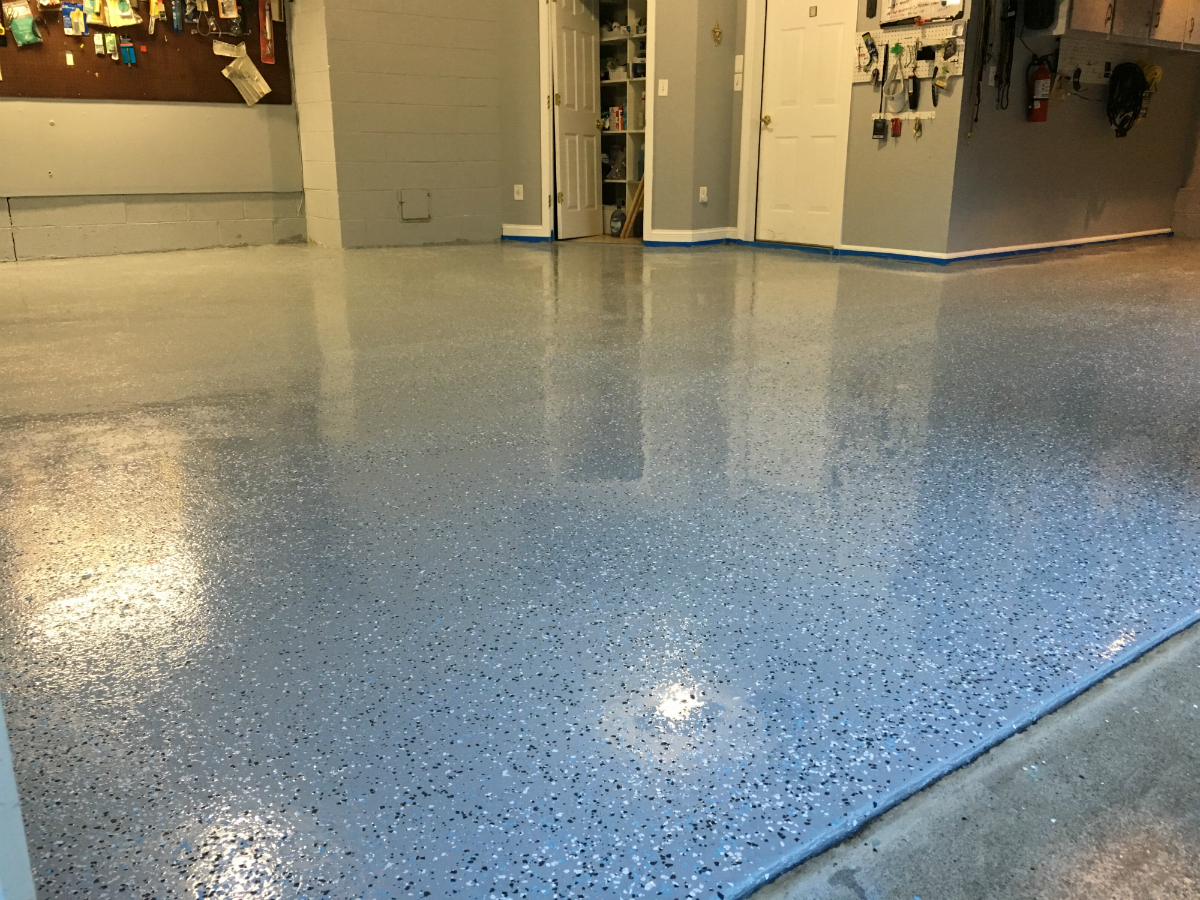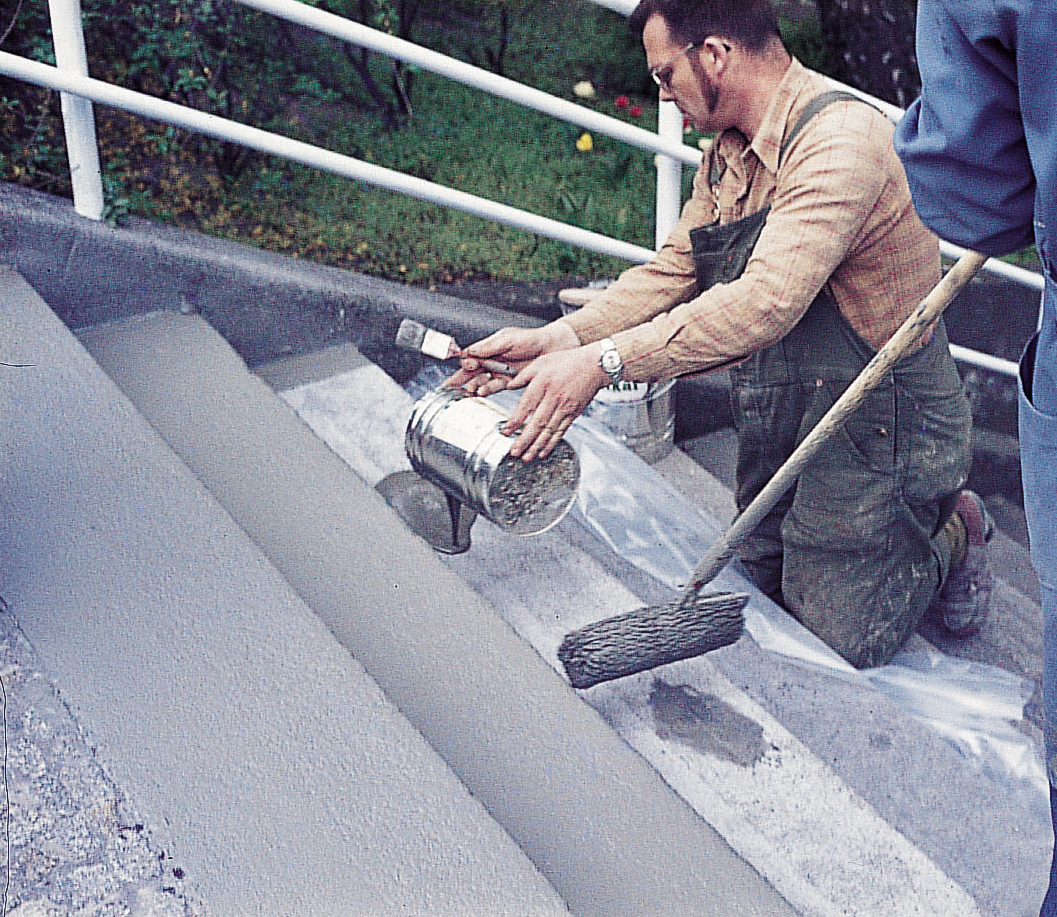Ever walked into a basement or garage and wondered, “How on Earth am I going to get this epoxy off my concrete floor?” You’re not alone. Epoxy, while a great sealant and protective coating, can be a real pain to remove when the time comes to update or make changes. But fret not, because this comprehensive guide will walk you through the best ways to remove epoxy from your concrete floor, equipping you with the knowledge and confidence to tackle this common home improvement challenge.

Image: blog.armorgarage.com
Removing epoxy from a concrete floor is essential when you want to change the existing finish, expose the original concrete underneath, or simply start afresh. It might seem like a daunting task, but with the right approach and tools, it can be done effectively and without causing unnecessary damage to your floor. This guide will delve into the different methods for epoxy removal, discuss the appropriate tools and materials, and offer helpful tips and tricks to ensure a successful outcome.
Understanding Epoxy and Its Removal
Before diving into the removal process, let’s first understand what epoxy is and why removing it can be tricky. Epoxy is a thermosetting resin that, when mixed with a hardener, undergoes a chemical reaction that transforms it from a liquid to a solid, creating a strong and durable coating. This durable nature is what makes it such a popular choice for sealing concrete floors, but it can also make removing it a challenge.
Methods for Removing Epoxy from Concrete Floors
The best method for removing epoxy from your concrete floor depends on several factors, including the type of epoxy, the thickness of the coating, and the condition of the concrete underneath. Here’s a breakdown of the most common methods, their pros and cons, and when to use them.
1. Mechanical Removal:

Image: www.silikalamerica.com
a. Grinding:
Grinding is a common method for removing epoxy, particularly when dealing with thicker coatings. A diamond-grit grinding wheel, attached to an angle grinder or a specialized floor grinder, effectively grinds away the epoxy layer.
- Pros: Effective for thick coatings, relatively quick, can be used on large areas.
- Cons: Generates dust, requires safety precautions, can damage the concrete if not used carefully.
b. Sanding:
For thinner epoxy coatings, sanding with a belt sander or a random orbital sander can be a suitable option. Choose sandpaper with a grit appropriate for the thickness of the epoxy.
- Pros: Less dust than grinding, can be used in tight spaces.
- Cons: Can be slow, not as effective for thick coatings.
2. Chemical Removal:
a. Epoxy Remover:
Specialty epoxy removers are chemical solutions designed to break down the epoxy bonds. They are typically applied to the epoxy layer and allowed to dwell for a specified time before the softened epoxy can be scraped away.
- Pros: Works well for thin coatings, less abrasive than mechanical methods.
- Cons: Can be messy, requires proper ventilation, may damage certain types of concrete.
b. Acetone:
Acetone is a common solvent that can be effective at removing thinner epoxy coatings. However, it is important to note that acetone can be harsh on certain materials and should be used with caution.
- Pros: Readily available, relatively inexpensive.
- Cons: Can be flammable, may damage concrete, not as effective for thick coatings.
Remember, it’s crucial to follow the manufacturer’s instructions for any chemical remover, ensuring proper ventilation, wearing safety gear, and using a test area to check for any impact on the floor before applying it to the entire surface.
3. Heat Removal:
Applying heat to the epoxy can also soften it and make removal easier.
a. Heat Gun:
A heat gun can be used to soften the epoxy, allowing you to scrape it off. This method works best for smaller areas.
- Pros: Relatively quick, can be used in tight spaces.
- Cons: Requires caution to avoid burning the concrete, can release fumes.
b. Propane Torch:
A propane torch is more powerful than a heat gun but should only be used by experienced individuals due to the risk of fire hazards. This method is effective for larger areas and thicker epoxy coatings.
- Pros: Very effective for thick epoxy, quick for large areas.
- Cons: Requires extreme caution, potential fire hazard, can damage concrete if not used properly.
Always prioritize safety when using heat to remove epoxy. Ensure adequate ventilation, wear protective gear, and avoid direct contact with the heated epoxy.
Choosing the Right Removal Method
The best method for removing epoxy from your concrete floor depends on factors such as:
- Type of epoxy: Some epoxy formulations are more resistant to removal than others.
- Thickness of the coating: Thicker coatings require more aggressive methods.
- Condition of the concrete: If the concrete is old or damaged, you may need to choose a gentler removal method.
- Your experience and skill level: Mechanical methods like grinding and sanding require more experience than chemical removal methods.
Consider these factors carefully before selecting the removal method. It’s always a good idea to test a small, inconspicuous area of the floor before tackling the entire surface.
Safety Precautions
Removing epoxy from a concrete floor can be messy and potentially hazardous. You must take safety precautions to protect yourself and your surroundings:
- Wear protective gear: Gloves, goggles, a face mask, and appropriate clothing will protect you from dust, fumes, and splashes.
- Ventilate the area: Ensure proper ventilation to prevent the build-up of dust and fumes.
- Use caution with chemicals: Handle epoxy removers and solvents with care, following the manufacturer’s instructions.
- Avoid contact with skin and eyes: Wash your hands thoroughly after handling epoxy removers or solvents.
- Keep away from heat and open flames: Many epoxy removers are flammable and should be used in well-ventilated areas away from heat and open flames.
- Clean up spills immediately: Clean up spills promptly to avoid slipping hazards and environmental pollution.
Remember, safety is paramount. Never skip safety measures, even for a seemingly simple task.
Additional Tips for Successful Epoxy Removal
Here are some additional tips to make your epoxy removal process easier and more successful:
- Scrape before you grind or sand: Use a putty knife or scraper to remove as much of the epoxy as possible before resorting to grinding or sanding.
- Work in sections: Divide the floor into smaller sections to make the removal process more manageable.
- Remove dust regularly: Vacuum or sweep up the dust frequently during the removal process to avoid creating a hazardous environment and ensure better visibility.
- Use a dust mask: Wear a dust mask to protect your lungs from airborne particles while grinding or sanding.
- Be patient: Removing epoxy takes time and effort. Avoid rushing the process to ensure a clean and efficient removal.
- Check for residual epoxy: After removing the epoxy, carefully check for any remaining residue and repeat the removal process if necessary.
These tips will help you achieve the best results and reduce the time and effort required for epoxy removal.
Best Way To Remove Epoxy From Concrete Floor
Conclusion
Removing epoxy from your concrete floor can be a challenging but achievable task. With the right method, tools, and safety precautions, you can effectively remove the epoxy and prepare your floor for its next purpose. Whether you’re planning to refinish your basement, create a new garage floor, or simply restore the original look of your concrete, this guide has provided you with the knowledge and practical advice you need to succeed in your epoxy removal project.





